After failing to achieve promotion to the Spanish second division last season, some Barcelona B players decided that their spell at the club was over. Important players of the squad that was eliminated in the promotion playoffs like Monchu, Jorge Cuenca, Sergio Akieme, Ludovit Reis or Abel Ruiz left the club after not being granted first-team minutes.
But some younger players decided to have another try and keep working to get their chance. One of them was Óscar Mingueza, a 1999-born centre-back who spent the 2019/20 season fighting for a position at Barcelona B in the Spanish third division. He only played 1,241 minutes, the 13th most in the squad, but still felt he had something to offer.
And Mingueza’s determination was rewarded quite soon this season. After starting the season again in the B squad, the injury problems in the defensive line of the first team (Umtiti, Araújo and Piqué have suffered injuries), the lack of depth (Umtiti wasn’t really considered given his injury record and Ronald Araújo wasn’t expected to impress) and the difficulties Koeman faced to get the best out of some players (Sergiño Dest took some time to adapt and Lenglet isn’t having a great season) allowed Mingueza to play for the first team sooner than expected, making his La Liga and UEFA Champions League debut in late November and becoming an important player since then.
At the moment of writing, Mingueza has played 30 games for the first team (24 starts) and has quietly established as an important player for Ronald Koeman’s tactics while also earning a call from Spain U21 for the European Championship. In this tactical analysis, we’ll look at why he has gone from a third-tier backup player to starting games for Barcelona.
Profile and data analysis
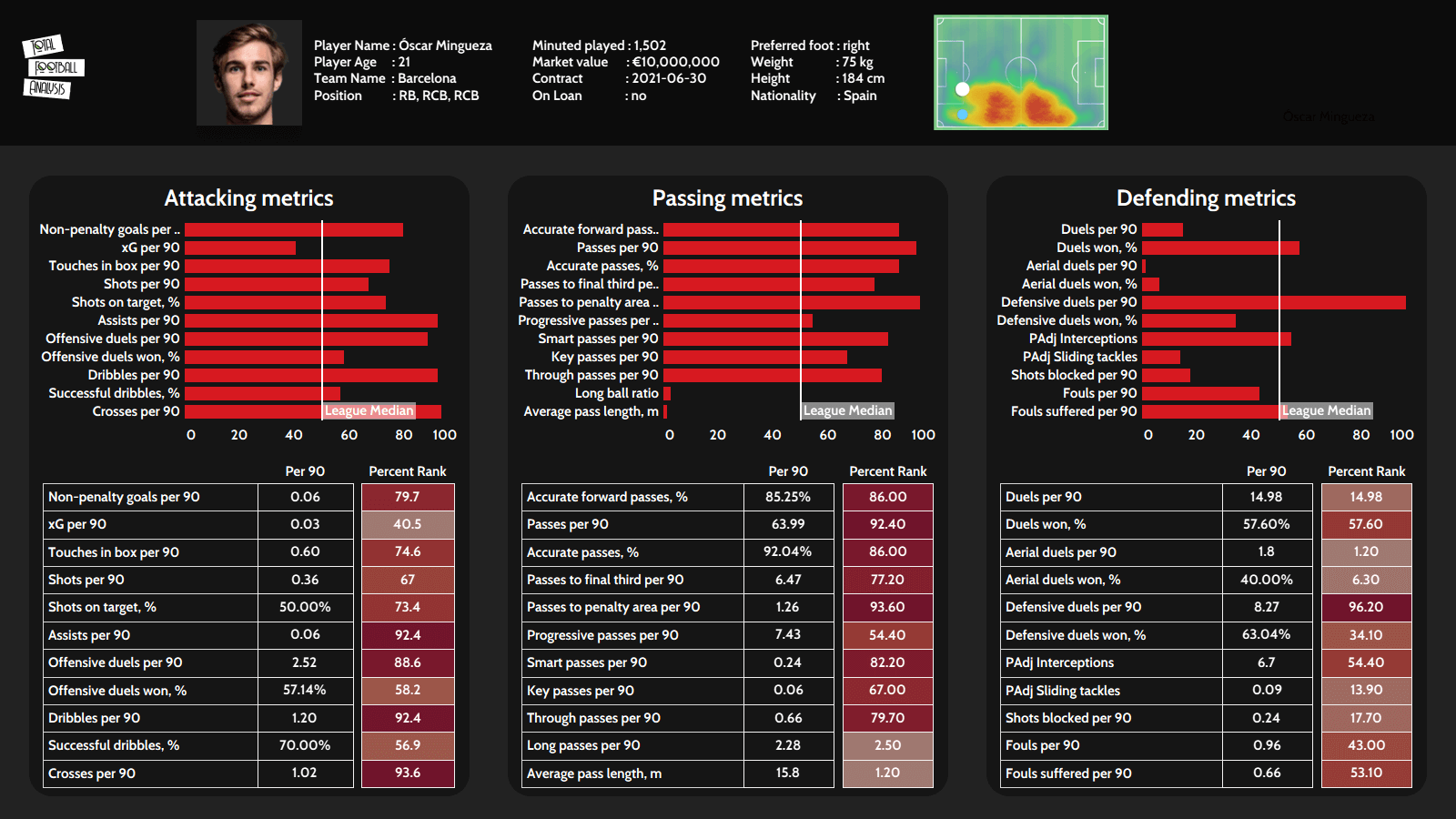
Standing at 184 cm, Mingueza has good size but isn’t especially tall for a centre-back. He’s well-coordinated, quick in long distances and with just decent mobility. As a right-back, he has some struggles against quick wingers but his pace is good for a centre-back even if his acceleration is his main weakness. He’s strong enough to play in La Liga but not a powerhouse who will bully forwards and he isn’t very good in the air.
Mingueza is an intelligent and well-educated player. Having played at every level for Barcelona since the U7s, he understands very well the requirements to play for the first team and adapts very quickly to any new challenge.
Apart from his understanding of the game, especially of Barcelona’s tactics, Mingueza doesn’t have any outstanding characteristics or weaknesses. Given the balanced nature of his game, the right centre-back position in a back-three seems to be the perfect position for him as he’s not tough enough for a centre-back yet and not skilled or fast enough for a full-back.
From the statistical point of view, Mingueza excels in virtually every attacking and passing metric as we would expect from a La Masía product. Having played some games at right-back also contributes to increasing his attacking figures but in general, he makes good decisions with the ball and the correct movements to make the best out of his good technique. In defence, he’s proactive and likes to press high and try to anticipate as we’ll see later on in this analysis but he lacks some strength and aggression to win duels both in the air and on the ground.
With his composed and intelligent playing style, Mingueza has earned the confidence of his teammates, who aren’t afraid of passing him the ball under pressure as he usually knows what to do and can keep the attacks fluid. He also shows good communication and is quite vocal for his age and position in the squad.
Proactive defending and high press
Let’s start this section of the analysis with Mingueza’s weakness: he’s not good at defending one-on-one situations. Mingueza lacks the mobility to turn quicker against agile forwards and his first couple of meters are quite slow so he’s usually beaten in short runs.
This issue forces him to adapt his playing style to avoid these situations. He has a quite good body shape that, even if he doesn’t recover the ball, forces rivals to go to less threatening positions and he rarely dives into tackles (just once this season). His pace in longer distances is much better so he prefers to defend big distances so he can recover after being beaten rather than small or medium spaces as he doesn’t have the time to recover his position once dribbled past.
Knowing he’s not the best at defending in individual duels, Mingueza looks to minimize them by showing a very proactive defending style. His first instinct when Barcelona lose the ball is to go up, press high and prevent rivals from turning and running at him. He looks to defend in the opposition half and 27% of his ball recoveries happen there.
Later on in this scout report, we’ll see he also tends to be positioned very high up the pitch during the attacks. This advanced position allows him to counter-press quickly and it’s a clear example of the positional game he’s been taught at La Masía. Looking to recover the ball in dangerous positions, he doesn’t track back immediately after Barcelona lose the ball, preferring to get forward and close down spaces to prevent rivals from running. The three centre-backs system gives him the security to press and leave spaces behind him as his back will usually be covered.
In the following picture, Sevilla have just recovered the ball and played a pass towards their left-back. Instead of tracking back into a compact defensive shape, Mingueza sprints forward to press in the final third and forces a goal kick with his quick reaction. This isn’t the normal reaction of a centre-back but understanding Barcelona’s demands and being well-positioned allow Mingueza to keep his team high-up the pitch.
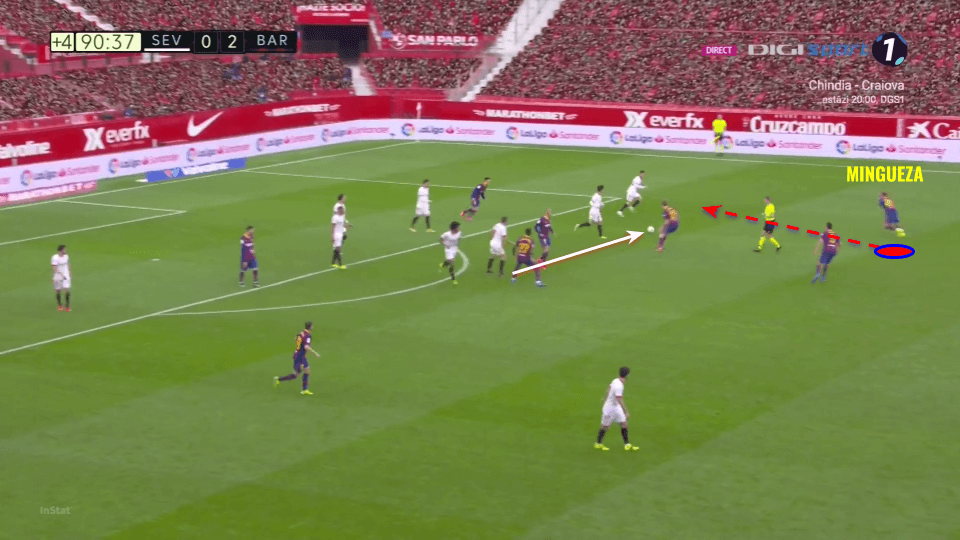
Mingueza stands out as a centre-back with excellent anticipation skills as a result of this proactive defending style. Despite not being the quickest in short spaces, he reacts very quickly and attacks the ball from good angles to prevent the forwards from receiving it. He doesn’t hesitate to follow the strikers when they drop deep to help in the build-up and can anticipate in the opposition half too, preventing a clean buildup from the rival team. Mingueza makes an average of 4.25 interceptions per 90, which become 6.7 when possession adjusted, better than 54.4% of La Liga centre-backs.
It’s also interesting to note that Mingueza often intercepts and passes forward in the same touch, launching quick transitions and getting his team forward before he can be pressed. This is because of his good reading of the game as he knows what he’ll do before he gets the ball.
In the next example, we see how aggressive Mingueza can be when it comes to anticipating in the opposition half. Real Sociedad are building from the back and Alexander Isak drops very deep to offer a passing option. Minguyeza follows him almost to the final third, intercepting the ball, passing it to Busquets with the same touch and creating a dangerous attack for Barcelona.
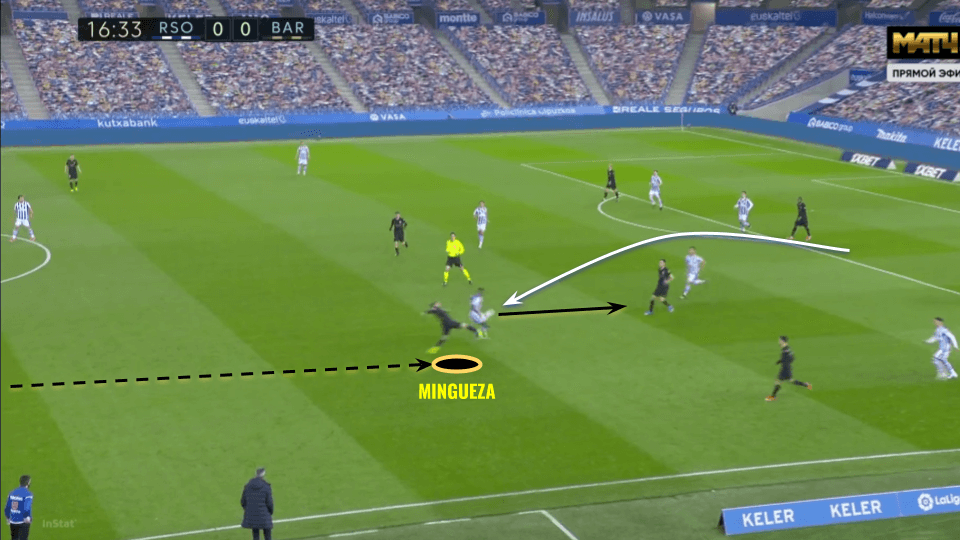
This advanced positioning and willingness to press and anticipate high up the pitch frees midfielders to press higher too, contributing to a better pressing structure for the whole team. In a team with Sergio Busquets, one of the best players in the world in a high-press, this contribution can’t be overlooked and has become crucial to Koeman’s tactics.
Mingueza’s defending style leads to lots of defensive duels (8.27 per, more than 96.2% of La Liga centre-backs). Of course, taking risks and trying to recover the ball in dangerous positions makes it more difficult for him to succeed and he wins just 63.04% of his defensive duels, which is low compared to every other centre-back but very good considering how valuable every defensive duel he wins is.
Apart from his problems in individual duels against quick rivals, Mingueza has another issue he needs to work on. His decision-making when tackling isn’t always the best; he commits some unnecessary fouls in dangerous positions, especially on the wings around the final third, which can lead to the rivals creating chances from set-pieces. He also takes too many risks inside the box and has conceded or been close to conceding some naive penalties this season. Of course, he’s still 21 and has time to improve but these issues need to be addressed by the coaching staff.
In the graph below, we see every foul Mingueza has conceded this season. The number of fouls isn’t worrying (0.96 per 90, less than 56% of La Liga centre-backs) but the position. Some of them in very dangerous positions (marked with a square) and he has also conceded a penalty.
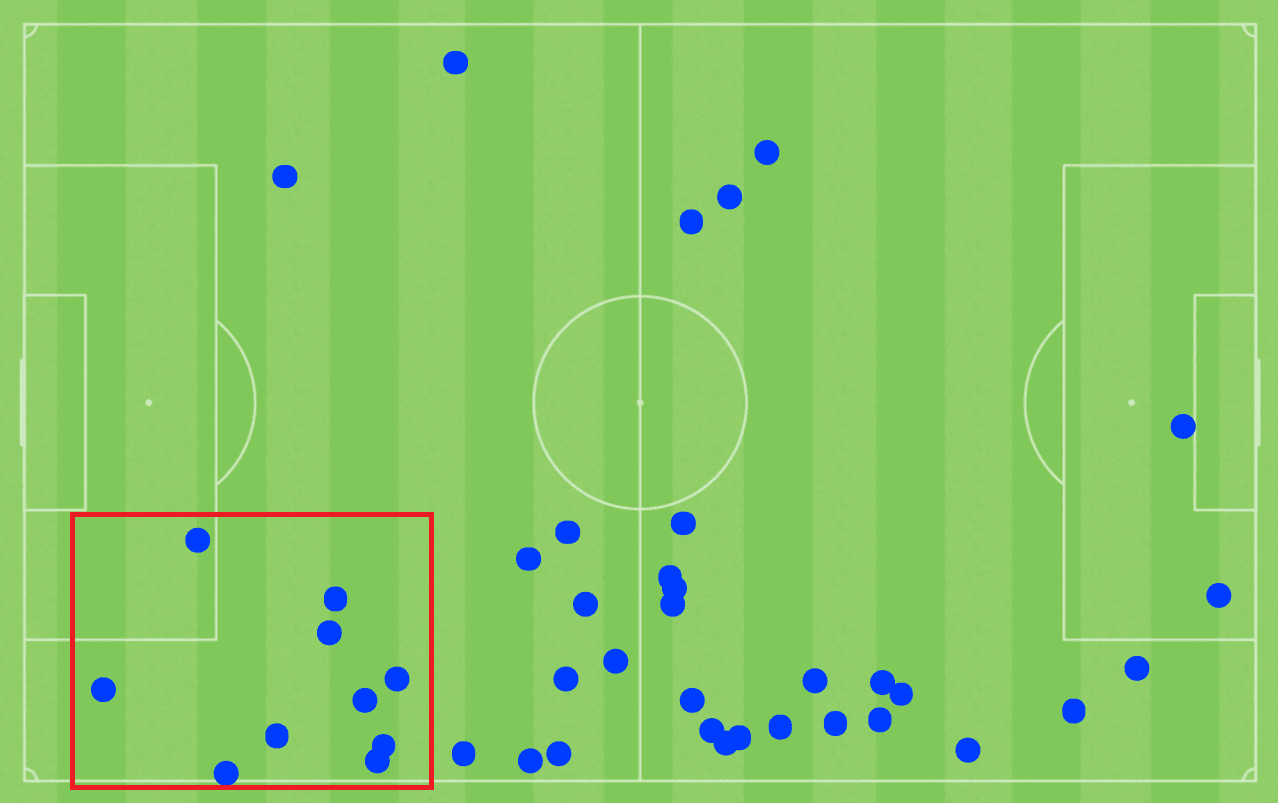
In general, we can say that Mingueza is a defender who fits very well into Barcelona’s tactics. He feels comfortable pressing high and knows how to do it thanks to his years at La Masía, reads the game well to anticipate and is fast enough to defend large spaces. He has some issues in one-on-one situations that would be problematic playing for other teams but he’ll surely work on solving them.
Occupation of spaces in positional attacks
In the current Koeman’s three centre-backs tactics, Mingueza occupies the right side. By watching his heatmap in the statistical profile provided above, we see that he occupies all the right side of the pitch from his own box up to the final third, which explains his excellent attacking output too.
When Barcelona have established themselves in the opposition half and are in a positional attack, Mingueza gets himself into a very advanced position in the right half-space, providing a passing option both for the wide and central players and getting ready to press quickly as we saw in the previous section of the analysis.
As a result of spending all his academy years at the club, Mingueza has developed a very high tactical IQ and understanding of the game, occupying the right spaces to distribute the ball. His position frees the right wing-back to push forward and make runs in behind as he’s perfectly located to cover his back and initiate a high press after Barça lose the ball. When the ball goes to the left, Mingueza tries to be close to the rivals to mark them quickly in case of a transition and when it’s coming back to the right he drifts wide to create passing lanes and provide width.
Below, we see Mingueza’s usual position during Barcelona’s positional attacks. He’s in an advanced position considering he’s a centre-back, provides a passing option for Busquets and frees Dest to attack and run in behind.
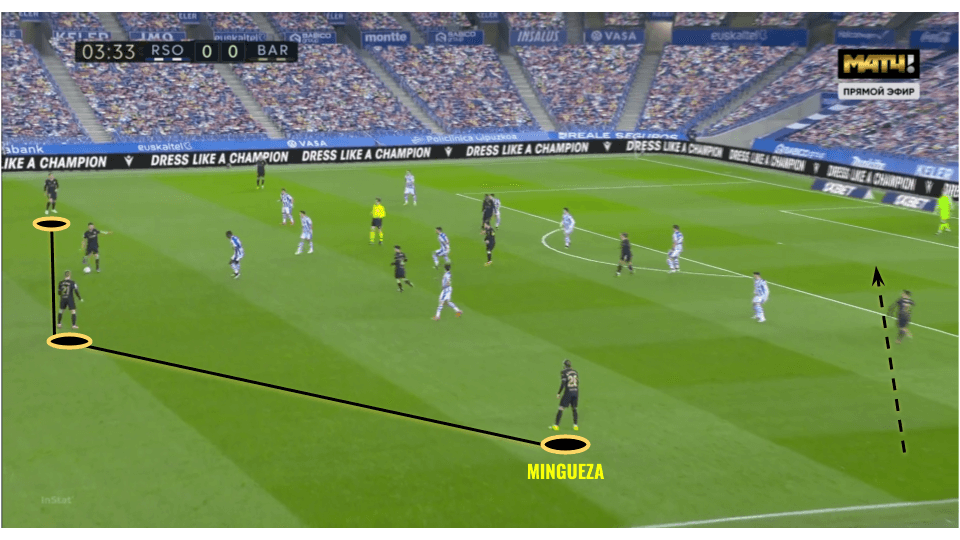
As expected, Mingueza has very good technique for a centre-back. He controls and drives the ball forward comfortably, has good passing range, is elegant in his movements and his mobility with the ball is better than defending, playing well in tight spaces.
When he gets the ball in the opposition half, Minfueza is composed and doesn’t rush. When he can’t advance he looks to attract rivals before playing simple passes so the team can switch sides quickly and attack the weak side.
He’s capable of playing quickly under pressure and with a solid technique as one would expect from a player raised in La Masía. Playing for the team with the highest possession in La Liga, Mingueza is very involved in the attacks with 63.99 passes per 90 (top 7.6%) and a passing accuracy of 92.04% (top 14%) that only drops to 85.25% in forward passes (top 14% too).
His high involvement means he gets lots of chances to progress and even take the ball into the penalty area but his numbers are still impressive even considering this and he ranks in the top 25% for almost every passing metric and only ranks very lowly in long passes per 90 and average pass length as expected from a Barcelona player.
In the build-up, Mingueza needs to improve his decisions as he has the quality to break pressing lines. He’s inconsistent against high-pressing teams and plays some dangerous passes that lead to threatening attacks against Barcelona. It’s normal that he still needs some adaptation to the high tempo of the games considering he was playing third-tier football less than a year ago. Playing in a back-three allows him to be less involved in his own half and he benefits from having Frenkie De Jong and Busquets leading the buildup.
The example below serves to illustrate one of these risky passes he needs to avoid. We see Mingueza on the ball and under heavy pressure from Real Sociedad. The rival forces him to rush into a decision and pass the ball to Busquets, who’s in a bad position to receive. A Real Sociedad player anticipates the pass and initiates a dangerous counterattack. On this occasion, Mingueza is quick to amend his mistake and recovers the ball.
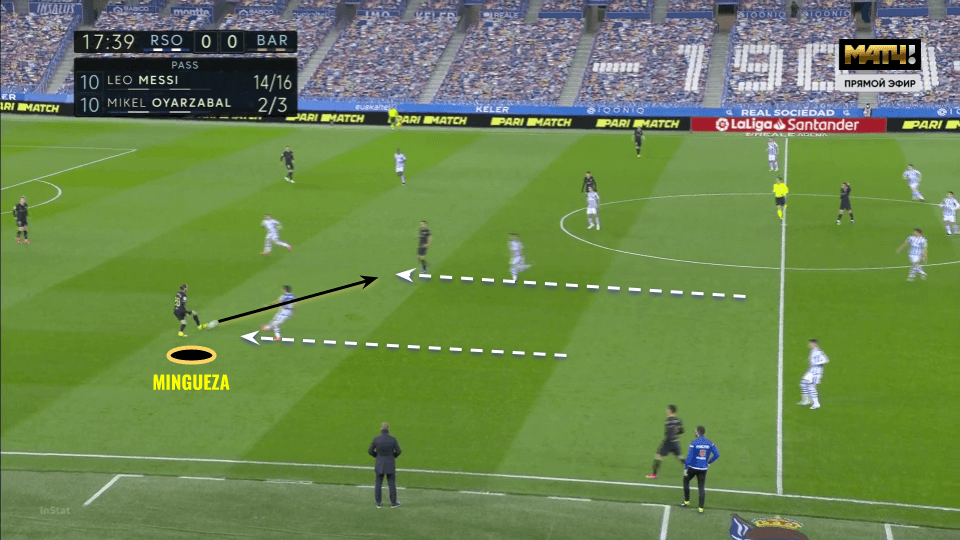
With plenty of room to improve, Mingeza is already an important part of Barcelona’s ball circulation and positional attacks. He has the technique and tactical concepts he needs to fit into the team and with some improvements on his consistency and decision making in dangerous areas, he’ll be a very good centre-back in the build-up department.
Creative output and attacking movements
His mixed position between a centre-back and a full-back means Mingueza usually has the chance to intervene high up the pitch and create more than a normal centre-back. In this section of the analysis, we’ll look at how he does that.
Mingueza’s technique is very good to drive the ball forward when he has space. When not pressed, he advances with the ball until he attracts rivals and then passes the ball to a better-positioned player. He has a very good understanding of how to create spaces by attracting rivals and great decision-making regarding when to go forward and attempt to create a chance and when to pass the ball back and protect possession.
Let’s take the play shown below as an example. Mingueza receives the pass from a central area and, seeing space in front of him, drives it towards the defensive line. As he advances, defenders are forced to make a decision and mark him and as soon as they do he passes the ball to Dest on the right side.
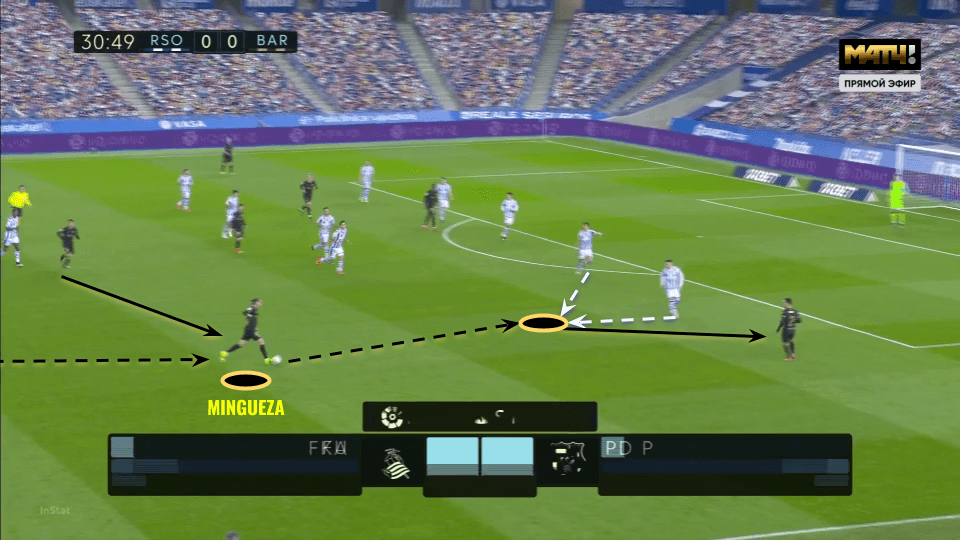
Sometimes these attempts to take the ball forward to force a movement from the rivals don’t work and Mingueza can be trapped between various rivals. However, he’s prepared for those situations and has a fine technique to turn with the ball and find his way out of pressure to restart the attacks.
In the example below, Mingueza drives the ball forward but is forced to turn back, getting caught between four Sevilla players. Instead of panicking, Mingueza takes a couple of touches to create a passing lane and plays the ball to Pedri, leaving the four players behind very effectively and achieving his original goal of attracting rivals.
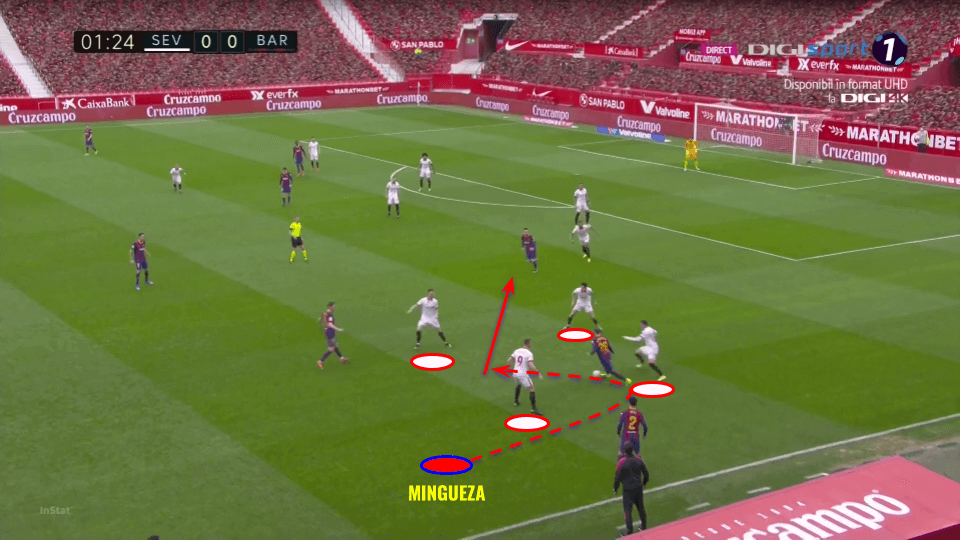
The main way Mingueza has of creating in the final third is his off-the-ball movements and his occupation of spaces. When his teammates in front of him move and free spaces, Mingueza doesn’t hesitate to get forward and act as a full-back too even from his right centre-back position. That’s why his crosses and dribbles are so high compared to the rest of the centre-backs in La Liga. His great timing to overlap means he usually has space and time to pick good positions for his crosses.
Mingueza prefers to play facing the goal to spot everything happening in front of him and decide where and when to run depending on his teammates’ movements and the spaces they open up. He feels comfortable making overlapping and underlapping runs and also providing width when the more advanced players drift inside. As a full-back, he makes lots of runs in behind and despite not being especially skilled he’s very difficult to handle given his work rate and intelligence.
When he gets into the final third, he shows surprisingly good crossing skills, usually attempting very tense crosses to the edge of the six-yard box that are very difficult to defend by the centre-backs and the goalkeeper.
Let’s look at the next sequence to understand his movements and work rate in attack. In the first picture below, Mingueza is overlapping on the right side as his teammates have drifted inside. Despite his good run in behind, Riqui Puig decides to play a short pass to Dembélé.
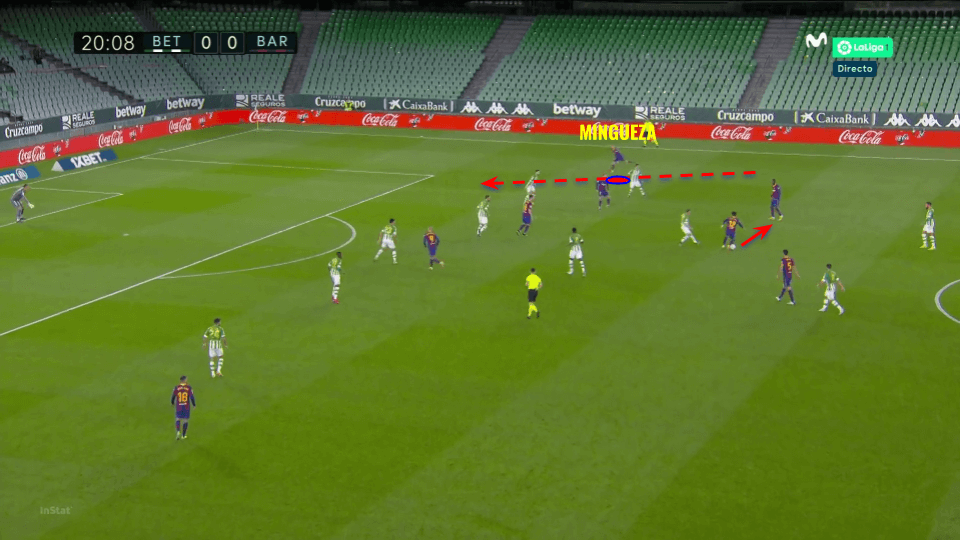
Instead of giving up, Mingueza quickly comes back to an onside position and attempts another similar run in behind just three seconds after the first one. This time, Dembélé decides to pass him the ball and finds his run with a very well-weighted through ball.
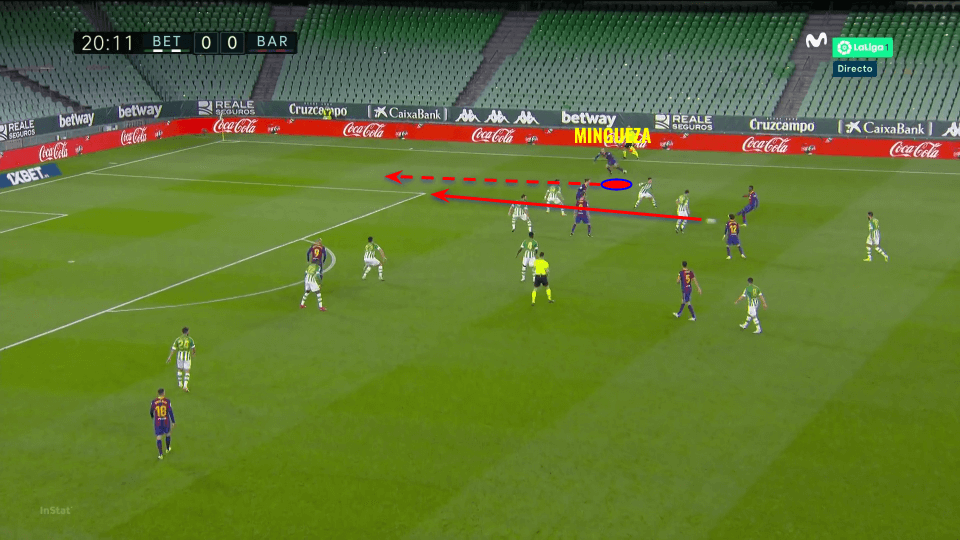
The good run gives Mingueza time to hit the ball with a good body shape and he puts a very good low cross trying to find Braithwaite at the near post but Betis’ defender intercepts it with a last-second tackle. Just five seconds pass between the first and the last picture but Mingueza does a lot to create this chance just with his determination and intelligence.
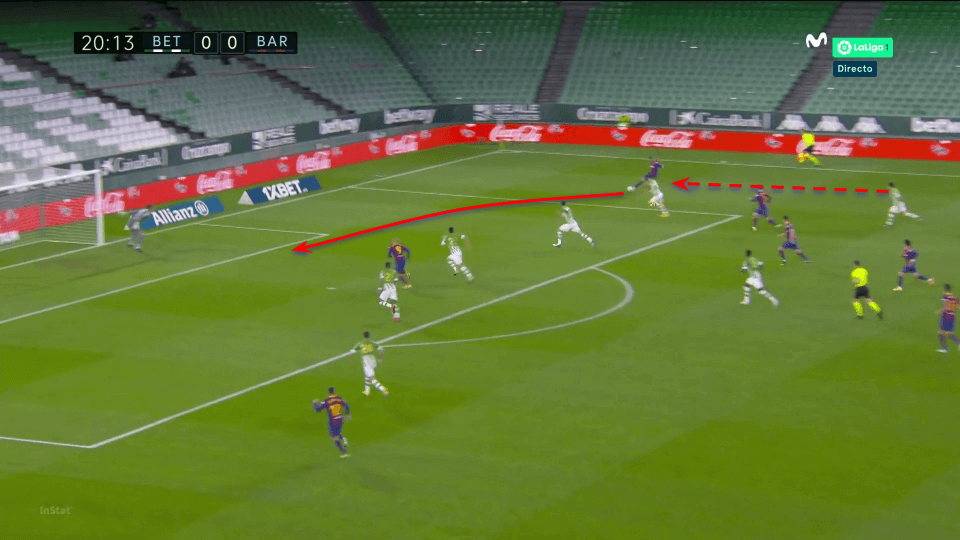
Of course, Mingueza doesn’t possess the ability to dribble players in tight spaces or assist with intricate and creative through passes but his movements and ability to adapt to what his teammates do is very valuable and enough to pose a threat to any team. His movements can also happen in central zones and he has options to shoot from open play quite open compared to other centre-backs, leading to an above-average 0.36 shots per 90.
Conclusion
Mingueza is a happy surprise in a complicated season for Barcelona. His growth from being a not especially promising player for Barcelona B to one of the important pieces in the first team has been spectacular even if forced by the circumstances.
His current deal expires next summer but Barcelona have an option to extend it for another two seasons and they’ll surely take that option. It seems unlikely that Mingueza becomes a regular starter once Barcelona have rebuilt their squad but a player with his adaptability and knowledge of the club should be a very valuable asset as a squad player and his exemplary behaviour in difficult situations (remember when he was subbed off in the first half against Ligue 1 leaders PSG) should be rewarded with an opportunity to keep playing for the only club he has played for in his career.





Comments